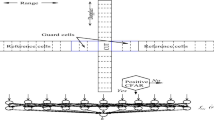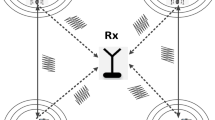Abstract
This paper deals with the application of neural networks to approximate the Neyman-Pearson detector. The detection of Swerling I targets in white gaussian noise is considered. For this case, the optimum detector and the optimum decision boundaries are calculated. Results prove that the optimum detector is independent on TSNR, so, under good training conditions, neural network performance should be independent of it. We have demonstrated that the minimum number of hidden units required for enclosing the optimum decision boundaries is three. This result allows to evaluate the influence of the training algorithm. Results demonstrate that the LM algorithm is capable of finding excellent solutions for MLPs with only 4 hidden units, while the BP algorithm best results are obtained with 32 or more hidden units, and are worse than those obtained with the LM algorithm and 4 hidden units.
An erratum to this chapter can be found at http://dx.doi.org/10.1007/11550907_163 .
Preview
Unable to display preview. Download preview PDF.
Similar content being viewed by others
References
Van Trees, H.L.: Detection, estimation, and modulation theory, vol. 1. Wiley, Chichester (1968)
Ruck, D.W., et al.: The multilayer perceptron as an aproximation to a Bayes optimal discriminant function. IEEE Trans. on Neural Networks. 1(1), 296–298 (1990)
Wan, E.A.: Neural network classification: A Bayesian interpretation. IEEE Trans. on Neural Networks 1(1), 303–305 (1990)
Gandhi, P.P., Ramamurti, V.: Neural Networks for Signal Detection in Non-Gaussian Noise. IEEE Trans. on Signal Proc. 45(11), 2846–2851 (1997)
Andina, D., Sanz-gonzalez, J.L.: On the problem of binary detection with neural networks. In: Proc. 38th Midwest Symp. on Circuits and Systems, vol. 1, pp. 13–16 (1995)
Andina, D., Sanz-Gonzalez, J.L.: Comparison of a neural network detector vs Neyman-Pearson optimal detector. In: Proc. of ICASSP 1996, USA, pp. 3573–3576 (1996)
Skolnik, M.: Radar Handbook, 2nd edn. McGraw-Hill, Inc., USA (1990)
Makhoul, J., El-Jaroudi, A., Schwartz, R.: Partitioning capabilities of two-layer neural networks. IEEE Trans. on Signal Proc. 39(6), 1435–1440 (1991)
Hagan, M.T., Menhaj, M.B.: Training feedforward networks with the Marquardt algorithm. IEEE Trans. on Neural Networks 5(6), 989–993 (1994)
Nguyen, D., Widrow, B.: Improving the learning speed of 2-layer neural networks by choosing initial values of the adaptive weights. In: Proc. of the Int. Joint Conf. on Neural Networks, vol. 3, pp. 21–26 (1990)
Grajal, J., Asensio, A.: Multiparametric importance sampling for simulation of radar systems. IEEE Trans. on Aerospace and Electronic Systems 35(1), 123–137 (1999)
Sanz-Gonzalez, J.L., Andina, D.: Performance analysis of neural network detectors by importance sampling techniques. Neural Proc. Letters (9), 257–269 (1999)
Author information
Authors and Affiliations
Editor information
Editors and Affiliations
Rights and permissions
Copyright information
© 2005 Springer-Verlag Berlin Heidelberg
About this paper
Cite this paper
de la Mata-Moya, D., Jarabo-Amores, P., Rosa-Zurera, M., López-Ferreras, F., Vicen-Bueno, R. (2005). Approximating the Neyman-Pearson Detector for Swerling I Targets with Low Complexity Neural Networks. In: Duch, W., Kacprzyk, J., Oja, E., Zadrożny, S. (eds) Artificial Neural Networks: Formal Models and Their Applications – ICANN 2005. ICANN 2005. Lecture Notes in Computer Science, vol 3697. Springer, Berlin, Heidelberg. https://doi.org/10.1007/11550907_145
Download citation
DOI: https://doi.org/10.1007/11550907_145
Publisher Name: Springer, Berlin, Heidelberg
Print ISBN: 978-3-540-28755-1
Online ISBN: 978-3-540-28756-8
eBook Packages: Computer ScienceComputer Science (R0)




